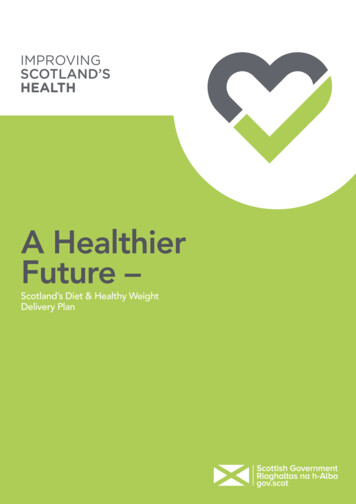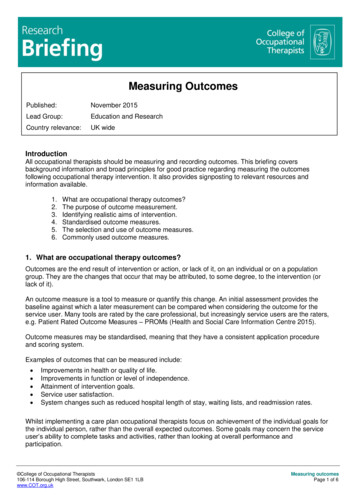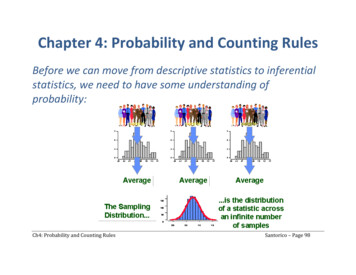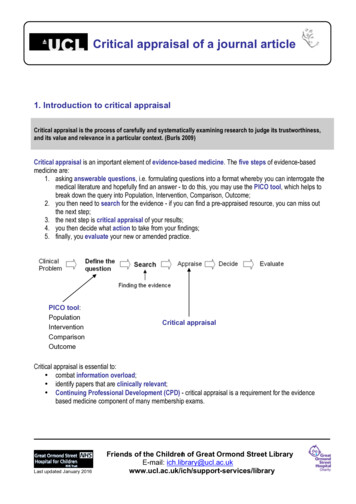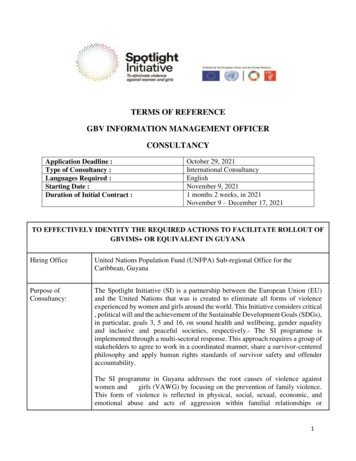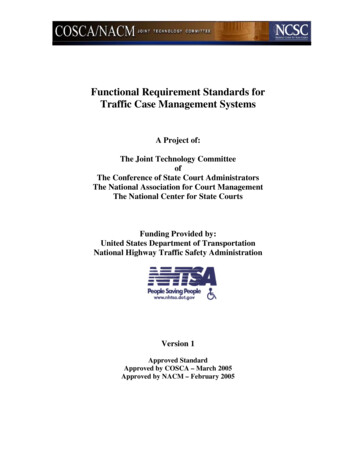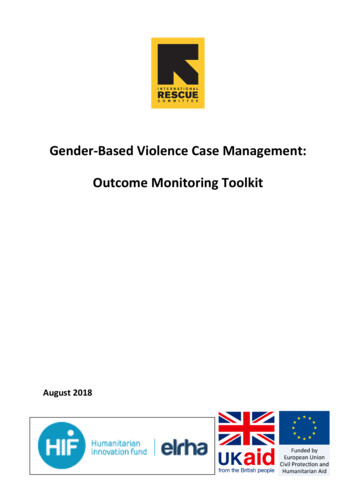
Transcription
Gender-Based Violence Case Management:Outcome Monitoring ToolkitAugust 2018
ContentsAcknowledgements. 3Part 1: Introduction. 4Part 2: How to use the GBV Case Management Outcome Monitoring Toolkit . 6Step 1: Introduce the toolki to the survivor. 6Step 2: Lead the survivor through the questionnaire . 6Step 3: Support the survivor to prioritize relevant activities and feelings . 6Step 4: Action planning . 6Part 3: Compile and Analyze the Results . 7Part 4: Use the Results . 10Annex 1: GBV Case Management Outcome Monitoring Questionnaires . 11Psychosocial Functionality Scale . 11Felt Stigma Scale . 12Annex 2: Visuals Guides . 14Adapted for Syrian Refugee Populations . 14Adapted for Somali Refugee Populations . 15Adapted for Eastern Regions of Democratic Republic of Congo . 18Annex 3: Contextualization and Adaptation Guide . 20Step 1: Deciding Whether or Not to Adapt . 21Step 2: Focus Group Discussion with Service Providers . 21Step 3: Adapting Visuals Guidance . 22Step 4: Piloting the Adapted Monitoring Tool . 232
AcknowledgementsThe development of the GBV Outcome Monitoring Toolkit is supported by Elrha’s HumanitarianInnovation Fund (HIF) program, a grant making facility supporting organizations and individuals toidentify, nurture and share innovative and scalable solutions to the most pressing challenges facingeffective humanitarian assistance. The HIF is funded aid from the UK Government and the DirectorateGeneral of the European Commission for Humanitarian Aid and Civil Protection (DG ECHO). Visitwww.elrha.org for more information about Elrha’s work to improve humanitarian outcomes throughresearch, innovation and partnerships. We thank all donors for their generous support of this project.Furthermore the International Rescue Committee would like to thank:Dr Sarah Murray at the Johns Hopkins Bloomberg School of Public Health for scale development, dataanalysis and interpretation.The IRC is also deeply indebted to previous research led by Dr Judith Bass and Dr Paul Bolton at JohnsHopkins Bloomberg School of Public Health, in collaboration with the IRC, in the Democratic Republicof Congo.The IRC’s Jordan and Kenya Women’s Protection and Empowerment (WPE) teams, who courageouslypersevered despite challenges. Reuben Nyaora for his beautiful drawings. Kathryn Falb, Marie-FranceGuimond, Sanni Bundgaard and Sarah Cornish for WPE research and programming guidance.And most importantly, the women who consented to participating in the study to rigorously test thistoolkit. This toolkit would not exist without them.3
Part 1: IntroductionThe humanitarian community has more knowledge and guidelines than ever to support qualitycomprehensive gender-based violence (GBV) response, including the Interagency GBV CaseManagement Guidelines, Caring for Child Survivors of Sexual Abuse, and Clinical Care for SexualAssault Survivors.1Monitoring and evaluation (M&E) is an important part of accountable and effective GBV response, buttraditionally the sector has focused on outputs (# of survivors receiving services, # of staff trained and# of dignity kits distributed).The GBV Case Management Outcome Monitoring Toolkit aims to measure outcomes, not outputs: theimpact of gender-based violence (GBV) case management on psychosocial well-being and feltstigma.This toolkit was inspired by IRC’s commitment to measure outcomes as part of its Outcomes andEvidence Framework, specifically the outcome “Women and girls are protected from and treated forthe consequences of GBV”.This toolkit was developed using validated scales measuring changes related to psychosocial wellbeingand stigma experienced by women survivors of GBV in the Democratic Republic of Congo2. The IRChas adapted this toolkit for use with women and older adolescent girls receiving GBV casemanagement support from Somali and Syrian populations.What does the GBV Case Management Outcome Monitoring Toolkit measure? The Psychosocial Functionality Scale is a 10-item questionnaire that measures a women andolder adolescent girls’ ability to carry out important tasks in their daily lives. The Felt Stigma Scale is a 10-item that measures women and older adolescent girls’ bothperceived and internalized experiences of stigma.Do I need to administer both scales?No. With each client, you can choose to administer only one of the scales, or you can administer bothof the scales (either during the same case management session or split across two sessions),depending on what aspects you and the client agree together to monitor.With whom can I use the GBV Case Management Outcome Monitoring Toolkit?The toolkit has been tested and validate for use with female survivors, 15 years old and over. Thetoolkit is not suitable for use with girls 14 years old or younger.When do I use the GBV Case Management Outcome Monitoring ://www.ncbi.nlm.nih.gov/pubmed/264601064
This tool can be used by GBV case managers, as part of the survivor’s psychosocial assessment. In theInteragency GBV Case Management Guidelines, this corresponds to Step 2 Assessment, Section 3:Psychosocial Needs and Support.It takes approximately 10-20 minutes to administer each of the questionnaires. For a one-time measure of psychosocial well-being and/or felt stigma: The tool only needs to beadministered once. We recommend that the monitoring tool be administered only after aminimum of three visits, in order for the most urgent needs of the survivors to be addressed andto give time for trust-building. Part 3 of this toolkit provides information on how to interpret thescores. To measure improvement of women and older adolescent girls recovery over time during casemanagement: To monitor change in survivors’ well-being over time, the monitoring toolquestionnaire should be administered at baseline (typically, the fourth case management sessionwith a survivor) and again after three additional sessions (typically at session 7). If possible,complete a final questionnaire at the end of the case management intervention plan, if it exceedscase management seven sessions. Part 3 of this toolkit provides information on how to interpretthe scores and level of change over time.5
Part 2: How to use the GBV Case Management Outcome Monitoring ToolkitStep 1: Introduce the tool to the survivorExplain: “In today’s session, I’d like to ask if you’d be interested in completing an activity togetherwhich will help us to understand how you are feeling currently in recovering from the violence you haveexperienced. These questions help us assess your feelings, your daily life activities and yourrelationships. Together, we can use your responses to help develop an action plan. Would you like tocomplete this activity together?”If the survivor agrees, proceed to step 2.Step 2: Lead the survivor through the questionnaireShow the survivor the contextualized illustration in Annex 1 or displayed on the wall of the GBV casemanagement area and/or safe space.Explain: “Now I will ask you some questions about the feelings, activities and relationships which youhave chosen as important to your recovery. Here is a picture which shows a woman holding a burden(basket, water can, etc) who is finding a task not difficult, a little difficult, Difficult, very difficult or soon. When you think about whether an activity or feeling is difficult or not, you can refer to this pictureas a guide”Do: Read out the questions from the Psychosocial Functionality Scale and/or Felt Stigma Scale(depending on what you wish to monitor) (see questionnaires for each scale in Annex 1).Do: Make sure that you are using the correct visual guidance / pictures. There are two versions: onefor the psychosocial functioning scale, and one for the felt stigma scale.Remind: “If you feel uncomfortable or wish to stop this activity at any time, please let me know.”Step 3: Support the survivor to select relevant feelings, activities and relationshipsExplain: “Thank you for answering all of these questions. You shared with me aspects of your life,including some which are currently difficult. Of all those items that we just discussed, which three tasks& activities or thoughts & feelings that you would most like to prioritize as we develop your actionplan? If you’d like, we can look through the questions that I just asked you, as a reference. You do notneed to select those that you rated as most difficult, but rather the ones that are most important toyou in terms of developing an action plan.”Do: Share the list of feelings and activities below with the survivor either on paper or verbally if thesurvivor has lower literacy levels. Pause after each section and ask her to select the examples mostrelevant to her action planning to support her recovery.Do: Review the items from the Psychosocial Functionality Scale and/or the Felt Stigma Scale with thesurvivor, as relevant.Step 4: Return to the action planning activity within your case management sessionNow you have supported the survivor to document how she is currently feeling and functioning, moveto action planning process and support the survivor to identify her goals for the coming week beforeyou meet again.6
Part 3: Compile and Analyze the ResultsPsychosocial Functionality ScaleAll items in the questionnaire are based on a 5-point scale, with the following values: Not difficult at all (0 point)A little bit difficult (1 point)Difficult (2 points)Very difficult (3 points)So difficult that you often cannot do it (4 points)Step 1: Calculate the results for an INDIVIDUAL woman or older adolescent girl1) Add the points across all 10 items2) Divide the total by 10.If the survivor skipped one or more item in the questionnaire, add the points for all answeredquestions, and divide by the total number of questions answered. For example, if the survivoranswered 8 questions, divide the sum by 8.Step 2: Interpret the results for an INDIVIDUAL woman or older adolescent girlScoreInterpretation & Action Planning0-1Survivor is experiencing little to no difficulty in accomplishing tasks.1-1.5Survivor is experiencing minimal and sometimes moderate amount of difficulty inaccomplishing tasks. Check whether the survivor indicated that specific items in the questionnaire weremore difficult to carry out (for example, she indicated that one item is ‘very difficult’)and ask the survivor if these ‘more difficult’ items should be the focus of her actionplan.1.5-2.25Survivor is experiencing moderate to significant difficulties in at least someaccomplishing tasks. It will be important to work with the survivor to help identify which tasks toprioritize for the survivor’s action plan. Note that the items do not necessarily needto be those that the survivor scored as most difficult, but can also be the tasks thatare most relevant to the survivor’s daily life.2.25-4Survivor is experiencing significant difficulties in accomplishing tasks, and may oftennot be able to carry these tasks out at all. It will be important to work with the survivor to help identify which tasks toprioritize for the survivor’s action plan. Note that the items do not necessarily needto be those that the survivor scored as most difficult, but can also be the tasks thatare most relevant to the survivor’s daily life. It may be advisable for the case managerto discuss cases with very high scores with their supervisors, in order to get additionaladvice on how to support these survivors as they may have specialized needs.Step 3: Interpret CHANGE OVER TIME for an INDIVIDUAL woman or older adolescent girlIf you would like to measure improvements in survivors’ well-being during the course of casemanagement, and you have at least two scores for a survivor over time (for example at session 4 andagain at session 7), you can compare the average for each questionnaire and calculate the differencebetween the average scores.7
Once you calculated the difference between scores, how do you interpret whether it is a “small” vs. a“large” change in the survivor’s scores? Based on the testing we conducted in Jordan and Kenya, wesuggest the following rule of thumb:Level of changeSmallMediumLargeDifference between scores (2nd score MINUS 1st score)0.170.340.67Step 4: Calculate the results across a CASELOAD of multiple women or older adolescent girlsIn order to get a good overview of the psychosocial functioning across your caseload, a visualrepresentation is most useful (see example graph in figure 1 below).We recommend a bar graph indicating the number of survivors in each score category (average scoresof 0 to 1; 1 to 1.5; 1.5 to 2.25; 2.25 to 4) plus the average across all survivors. Why not just use theaverage? It may hid a lot of variation across your caseload that requires specific attention. Forexample, you may have a number of woman or older adolescent girls with very high scores that requireadditional support, for example specialized therapies.Figure 1: EXAMPLE Psychosocial Functionality ScoresMM / YY2213650 to 11 to 1.51.5 to 2.252.25 to 4Average Psychosocial Functionality score across 46 clients: 2.33.Felt Stigma ScaleThe Felt Stigma questions are based on a 4-point scale, with the following values: Not at all (0 point)A little bit (1 point)A moderate amount (2 points)A lot (3 points)Step 1: Calculate the results for an INDIVIDUAL woman or older adolescent girl1) Add the points across all 10 items2) Divide the total by 10.If the survivor skipped one or more item in the questionnaire, add the points for all answeredquestions, and divide by the total number of questions answered. For example, if the survivoranswered 8 questions, divide the sum by 8.Step 2: Interpret the results for an INDIVIDUAL woman or older adolescent girl8
ScoreInterpretation & Action Planning0-1Survivor is experiencing little to no felt stigma1-2Survivor is experiencing minimal to moderate amount of felt stigmaCheck whether the survivor indicated that specific items in the questionnaire were more difficult (forexample, she indicated that one item is ‘very difficult’) and ask the survivor if these ‘more difficult’ itemsshould be the focus of her action plan.2-3Survivor is experiencing moderate to significant difficulties in accomplishing tasks.The survivor is likely having difficulties related to a number of feelings related to felt stigma. It will beimportant to work with the survivor to help identify which feelings to prioritize for the survivor’s actionplan. Note that the items do not necessarily need to be those that the survivor scored as most difficult,but can also be the feelings and experiences that are most relevant to the survivor’s daily life.Step 3: Interpret CHANGE OVER TIME for an INDIVIDUAL woman or older adolescent girlIf you would like to measure change in survivors’ experiences of felt stigma during the course of casemanagement, and you have at least two scores for a survivor over time (for example at session 4 andat session 7), you can compare the average for each questionnaire and calculate the differencebetween the scores.Based on the testing we conducted in Jordan and Kenya, we suggest the following rule of thumb toassess level of change between scores:Level of changeSmallMediumLargeDifference between scores (2nd score MINUS 1st score)0.20.61.2Step 4: Calculate the results across a CASELOAD of multiple women or older adolescent girlsIn order to get a good overview of the experiences of felt stigma across your caseload, a visualrepresentation is most useful (see example graph in figure 2 below).We recommend a bar graph indicating the number of survivors in each score category (average scoresof 0-1; 1-2; 2-3) plus the average across all survivors. Why not just use the average? It may hid a lot ofvariation across your caseload that requires specific attention.Figure 2: Stigma Scores for SurvivorsMM / YY8765432107620 to 11 to 22 to 3Average Felt Stigma score across 15 clients: 2.3.9
Part 4: Use the ResultsThere are two main objectives of the GBV Case Management Outcome Monitoring Toolkit, one is tohelp provide GBV case managers with a tool to support their work with individual women and olderadolescent girls. Measuring progress together can inform better targeted psychosocial supportstrategies by the case manager and action planning by the client. It can also inform referrals for higherlevel mental health care where needed.The second objective is to provide GBV response teams with high-quality, aggregated data onpsychosocial functioning and stigma across your client caseload to inform programmingimprovements. To achieve this second objectives, it is critical that the aggregated results collectedfrom the Psychosocial Functionality Scale and Felt Stigma Scale are analyzed and discussed in order todevelop actionable recommendations.The de-identified3 results from the Outcome Monitoring Toolkit can be used: To report on case management outcomes to stakeholders (including women and girlsthemselves). To measure change in the woman or older adolescent girls well-being over time, during thecourse of case management (*requires each survivor answered the questionnaire at leasttwice, for example at session 4 and again at session 7). To inform improvements in GBV case management approaches, to better address needs ofwomen and girl survivors of GBV; and,3De-identified data should not include : first names of subjects, last names of subjects, dates of birth, dates ofbirth, addresses or GPS locations, identifying photos, phone numbers, unique ID numbers (such as nationalIDs).10
Annex 1: GBV Case Management Outcome Monitoring QuestionnairesPSYCHOSOCIAL FUNCTIONALITY SCALEI will ask you about specific tasks and activities. Thinking about the last four weeks, please tell me howdifficult it is for you to carry out these activities. You will tell me if it is [point at the same time to Visual Aid1]: Not difficult at allDifficultA little bit difficultVery difficultSo difficult that you often cannot do it.1. Giving advice to family members1.2.3.4.5.Not difficult at all (0 pts)A little bit difficult (1 pt)Difficult (2 pts)Very difficult (3 pts)So difficult that you often cannot do it (4 pts)2. Exchanging ideas with others1.2.3.4.5.Not difficult at all (0 pts)A little bit difficult (1 pt)Difficult (2 pts)Very difficult (3 pts)So difficult that you often cannot do it (4 pts)3. Uniting with other community membersto do tasks for the community1.2.3.4.5.Not difficult at all (0 pts)A little bit difficult (1 pt)Difficult (2 pts)Very difficult (3 pts)So difficult that you often cannot do it (4 pts)4. Asking/getting help from people ororganizations when you need it1.2.3.4.5.Not difficult at all (0 pts)A little bit difficult (1 pt)Difficult (2 pts)Very difficult (3 pts)So difficult that you often cannot do it (4 pts)5. Making important decisions about dailylife1.2.3.4.5.Not difficult at all (0 pts)A little bit difficult (1 pt)Difficult (2 pts)Very difficult (3 pts)So difficult that you often cannot do it (4 pts)6. Taking part in family decisions1.2.3.4.5.Not difficult at all (0 pts)A little bit difficult (1 pt)Difficult (2 pts)Very difficult (3 pts)So difficult that you often cannot do it (4 pts)7. Learning new skills1.2.3.4.5.Not difficult at all (0 pts)A little bit difficult (1 pt)Difficult (2 pts)Very difficult (3 pts)So difficult that you often cannot do it (4 pts)8. Concentrating onresponsibilitiesyourtasksor1.2.3.4.Not difficult at all (0 pts)A little bit difficult (1 pt)Difficult (2 pts)Very difficult (3 pts)11
5. So difficult that you often cannot do it (4 pts)9. Interacting or dealing with people youdon’t know1.2.3.4.5.Not difficult at all (0 pts)A little bit difficult (1 pt)Difficult (2 pts)Very difficult (3 pts)So difficult that you often cannot do it (4 pts)10. Keeping your household clean1.2.3.4.5.Not difficult at all (0 pts)A little bit difficult (1 pt)Difficult (2 pts)Very difficult (3 pts)So difficult that you often cannot do it (4 pts)FELT STIGMA SCALEThinking about the last four weeks, please tell me how much you have had these thoughts and feelings.You will tell me if it is [point at the same time the visual aid 2]: Not at all A little bit A moderate amount A lot1. Feelings of worthlessness, of having novalue1.2.3.4.Not at all (0 pts)A little bit (1 pt)A moderate amount (2 pts)A lot (3 pts)2. Feeling detached or withdrawn fromothers1.2.3.4.Not at all (0 pts)A little bit (1 pt)A moderate amount (2 pts)A lot (3 pts)3. Feeling badly treated by communitymembers1.2.3.4.Not at all (0 pts)A little bit (1 pt)A moderate amount (2 pts)A lot (3 pts)4. Feeling shame1.2.3.4.Not at all (0 pts)A little bit (1 pt)A moderate amount (2 pts)A lot (3 pts)5. Blaming yourself for past events.1.2.3.4.Not at all (0 pts)A little bit (1 pt)A moderate amount (2 pts)A lot (3 pts)6. Feeling rejected by everybody1.2.3.4.Not at all (0 pts)A little bit (1 pt)A moderate amount (2 pts)A lot (3 pts)7. Feeling stigma1.2.3.4.Not at all (0 pts)A little bit (1 pt)A moderate amount (2 pts)A lot (3 pts)8. Wanting to avoid other people or hide1. Not at all (0 pts)12
2. A little bit (1 pt)3. A moderate amount (2 pts)4. A lot (3 pts)9. Feeling like your family gazes at you likethey are blaming you1.2.3.4.Not at all (0 pts)A little bit (1 pt)A moderate amount (2 pts)A lot (3 pts)10. Feeling like community members gaze atyou like they are blaming you1.2.3.4.Not at all (0 pts)A little bit (1 pt)A moderate amount (2 pts)A lot (3 pts)13
Annex 2: Visuals GuidesAdapted for Syrian Refugee PopulationsVisuals for PsychosocialFunctionality ScaleNot difficult atallA little bitdifficultModerateamountVery difficultUnable to carrythis out
Visuals for Felt Stigma ScaleAdapted for Somali Refugee PopulationsNot at allA little bitA moderate amountA lot15
Visuals for PsychosocialFunctionality ScaleNot difficult atallA little bitdifficultModerateamountVery difficultUnable to carrythis out16
Visuals for Felt Stigma Scale17
Adapted for Eastern Regions of Democratic Republic of CongoVisuals for Psychosocial Functionality ScaleHakuna shidaao magumuShida aomagumukidogo sanaShida ao magumukwa kadiriUn peu dedifficultéUn niveau moyen dedifficulté.Aucune difficultéShida ao magumuzaidiBeaucoup dedifficultéShida ao magumusana hata hawezikuifanyaTellement de difficultéqu’elle ne peut pas lefaire18
Visuals for Felt Stigma ScaleHata kamweKidogopas du toutun peuKiasi ya kadiriMingiun niveau moyen.beaucoup19
Annex 3: Contextualization and Adaptation GuideSteps to Adapt the Outcome Monitoring Tool to your ContextThe GBV Case Management Outcome Monitoring Toolkit was tested and validated for two differentpopulations of women and older adolescent girls: Syrian refugees and Somali refugees, and the initialversion of the scales were developed for the eastern region of Democratic Republic of Congo. The 10item Psychosocial Functionality Scale and the 10-item Felt Stigma Scale are effective and culturallyappropriate measures in these and similar settings. For any other populations, we also recommendthat you use the two scales without modifications or deletions.However, you can choose to add additional questions that are addressing specific aspects of yourprogramming context, especially if there are certain daily activities, experiences of relationships, orexpressions of feelings that are prevalent to that context. Be mindful of the additional time it willtake to answer additional items and whether this additional information will provide criticalinformation to improve your program and/or advocacy efforts.For example, for the Psychosocial Functionality Scale, the standard items (which we recommend foruse in all settings, without modifications or deletions) are as follows:1.2.3.4.5.6.7.8.9.10.Giving advice to family membersExchanging ideas with othersUniting with community members to do tasks for the communityAsking/getting help from people or organizations when you need itMaking important decisions about daily lifeTaking part in family decisionsLearning new skillsConcentrating on your tasks/responsibilitiesInteracting or dealing with people you do not knowKeeping your household cleanHowever, you may decide to add additional, optional items from this list:11.12.13.14.15.16.17.18.Giving advice to other community membersUniting with other family members to do tasks for the familySocializing with others in the communityTaking part in family decisionsTaking part in community eventsGo to church or to mosque as usual, or praying as usualGo to the market or grocery store or purchase other needed goodsPresent yourself well (e.g. having good hygiene, getting dressed).For the Felt Stigma Scale, the standard items (which we recommend for use in all settings, withoutmodifications or deletions) are as follows:1.2.3.4.Feelings of worthlessness, of having no valueFeeling detached or withdrawn from othersFeeling badly treated by community membersFeeling shame20
5.6.7.8.9.10.Blaming yourself for past events.Feeling rejected by everybodyFeeling stigmaWanting to avoid other people or hideFeeling like your family gazes at you like they are blaming youFeeling like community members gaze at you like they are blaming youHowever, you may decide to add additional, optional items from this list:11. Feeling badly treated by family members12. Feeling like friends and classmates at school gaze at you like they are blaming youStep 1: Deciding Whether or Not to AdaptThe existing case management data in your programming area can provide important information onwhether to adapt the GBV Case Management Outcome Monitoring Toolkit: Age: the monitoring toolkit was developed and has currently only been tested with femalesurvivors aged 15 years and older. For female survivors 15-19 years old, you will want toconsider whether they have similar social roles to women who are more than 19 years old.For example, if many are in school, you may want to add a few questions related to theirfeelings and perceptions of stigma at school, for example.We do not recommend adapting the toolkit for younger girls (14 years old and younger) beforerigorous testing is available with this younger population of girls. Heterogeneity of origin, cultural background and religion: the Outcome Monitoring Toolkitwas adapted for use with women and older adolescent girls who are Syrian refugees andSomali refugees as well as women and girls from Eastern DRC. If you decide to adapt the tools,it will be important to include perspectives that are representative of your interventionpopulation (religion, ethnicity, etc) to ensure that the tool is appropriate. Gender: the monitoring toolkit was developed and has currently only been tested with femalesurvivors. We do not recommend adapting the tool for male survivors of sexual violencebefore rigorous testing is available with adult men and adolescent boys who have experiencedsexual assault.Step 2: Focus Group Discussion with Service ProvidersWe recommend Focus Group Discussions with GBV response teams to help identify any additionalitems for inclusion in the scale.Preparations: We recommend that the focus groups be conducted by a female facilitator and supported bya female note-taker.If available, and if all participants consent, use a recording device to create an audio file of thefocus group discussion.21
Note that we recommend that a note-taker write “bullet point” notes of the focus groupdiscussions even when you planned for audio recording, in case of any issues with therecording or if not all participants consent to the use of audio recording.Number of Focus Groups and Participants: Consider holding two focus groups per location/or by population group (especially in areaswhich are spread out over a large area).o If your programming covers a large number of areas and it is not feasible or costefficient to hold two focus groups per location then aim to reach a diverse sample ofwomen and older adolescent girls. Consider holding focus groups which will reachGBV response teams working in urban/rural con
Monitoring and evaluation (M&E) is an important part of accountable and effective GBV response, but traditionally the sector has focused on outputs (# of survivors receiving services, # of staff trained and # of dignity kits distributed). The GBV Case Management Outcome Monitoring Toolkit aims to measure outcomes, not outputs: the



